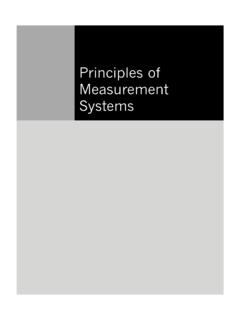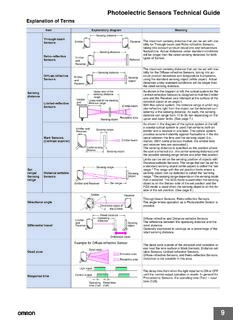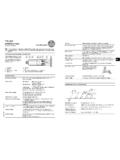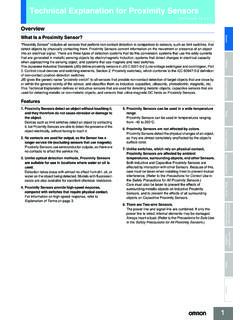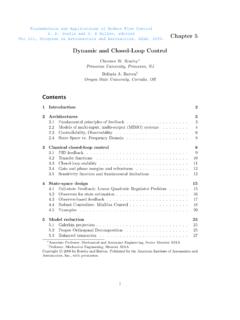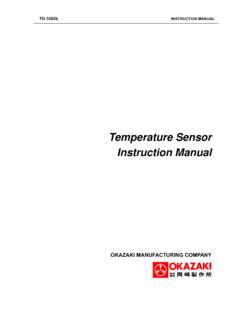Transcription of INSTRUMENTATION AND CONTROL TUTORIAL 2 – …
1 1 INSTRUMENTATION AND CONTROL TUTORIAL 2 SENSORS AND PRIMARY TRANSDUCERS This TUTORIAL provides an overview of instrument sensors used in process and automatic CONTROL . It is useful to anyone studying measurement systems and INSTRUMENTATION but it is provided mainly in support of the EC module D227 CONTROL System Engineering. This TUTORIAL is mainly descriptive. CONTROL is a broad concept and the following might apply to an automated system such as a robot or to a process CONTROL system such as a pneumatic valve controlling the flow of steam in a pipe. On completion of this TUTORIAL , you should be able to do the following.
2 Explain a basic measurement system. Explain the basic working principles of a variety of temperature sensors. Explain the basic working principles of a variety of pressure sensors. Explain the basic working principles of a variety of speed transducers. Explain the basic working principles of a variety of flow meters. Explain the basic working principles of a variety of force gauges. Explain the basic working principles of a variety of displacement gauges. Explain the basic working principles of a variety of level (depth) gauges. Explain in some detail the theory and use of strain gauges. In order to complete the theoretical part of this TUTORIAL , you must be familiar with basic mechanical and electrical science.
3 2 1. INTRODUCTION A basic instrument system consists of three elements: i sensor or INPUT DEVICE ii SIGNAL PROCESSOR iii RECEIVER or OUTPUT DEVICE This TUTORIAL is devoted to input devices but you can never separate it from the rest of the system as in many cases they are all integral ( a mechanical pressure gauge incorporates all of these elements). A block diagram of a basic system is shown but they are usually more complex. Figure 1 Most modern analogue equipment works on the following standard signal ranges. Electric 4 to 20 mA Pneumatic to bar Older electrical equipment use 0 to 10 V. Increasingly the instruments are digital with a binary digital encoder built in to give a binary digital output.
4 Pneumatic signals are commonly used in process industries for safety especially when there is a risk of fire or explosion. The advantage of having a standard range or using digital signals is that all equipment may be purchased ready calibrated. For analogue systems the minimum signal (Temperature, speed, force, pressure and so on ) is represented by 4 mA or bar and the maximum signal is represented by 20 mA or bar. This TUTORIAL is an attempt to familiarise you with the many types of input sensors on the market today. Usually such sensors are called PRIMARY TRANSDUCERS. Things that we commonly measure are: Temperature Pressure Speed Flow rate Force Movement, Velocity and Acceleration Stress and Strain Level or Depth Mass or Weight Density Size or Volume Acidity/Alkalinity Sensors may operate simple on/off switches to detect the following: Objects(Proximity switch) Empty or full (level switch) Hot or cold (thermostat) Pressure high or low (pressure switch) The block diagram of a sensor is shown below.
5 Figure 2 3 2 TEMPERATURE TRANSDUCERS THERMOCOUPLES When two wires with dissimilar electrical properties are joined at both ends and one junction is made hot and the other cold, a small electric current is produced proportional to the difference in the temperature. Seebeck discovered this effect. It is true no matter how the ends are joined so the cold end may be joined at a sensitive millivolt meter. The hot junction forms the sensor end. Figure 3 The picture shows a typical industrial probe with a flexible extension and standard plug. Figure 4 Peltier showed that heat is absorbed at the hot end and rejected at the cold end.
6 Thompson showed that part of the is due to the temperature gradient in the wire as well as the temperature difference between the junctions. Most thermocouple metals produce a relationship between the two temperatures and the as follows. e = ( 1 - 2) + ( 12 - 22 and are constants for the type of thermocouple. The relationship is nearly linear over the operating range. The actual characteristic and suitable operating temperatures depends upon the metals used in the wires. The various types are designated in international and national standards. Typical linear operating ranges are shown for standard types.)
7 It is important that thermocouples are standard so that the same will always represent the same temperature. 4 Thermocouples come in several forms. They may be wires insulated from each other with plastic or glass fibre materials. For high temperature work, the wire pairs are put inside a tube with mineral insulation. For industrial uses the sensor comes in a metal enclosure such as stainless steel. RESISTANCE TYPE SENSORS Figure 5 These work on the principle that the electrical resistance of a conductor change with temperature. If a constant voltage is applied to the conductor then the current flowing through it will change with temperature.
8 The resistivity of the conductor change with temperature. This usually means the resistance gets bigger as the conductor gets hotter. The following law relates the resistance and temperature. R = Ro(1 + ) is the temperature coefficient of resistance. Ro is the resistance at 0oC. Sometimes the equation is given as R = Ro(1 - 2) A basic temperature sensor is made by winding a thin resistance wire into a small sensor head. The resistance of the wire then represents the temperature. This has an advantage over a thermocouple in that it is unaffected by the temperature of the gauge end. The main type of wire used is PLATINUM. The sensors are usually manufactured to have a resistance of 100 at 0oC and the value of is to A typical operating range is -200 to 400oC.
9 A special type of resistance sensor is called a THERMISTOR. They are made from a small piece of semi-conductor material. The material is special because the resistance changes a lot for a small change in temperature and so can be made into a small sensor and it costs less than platinum wire. The temperature range is limited. They are only used for a typical range of -20 to 120oC and are commonly used in small hand held thermometers for every day use. The relationship between resistance and temperature is of the form R = AeB/ Type J 0 to 800oC Type K 0 to 1200oC Type T -199 to 250oC Type E 0 to 600oC Type R/S 0 to 1600oC Type B 500 to 1800oC Type N 0 to 1200oC Type L 0 to 800oC 5 WORKED EXAMPLE A Platinum resistance thermometer has a resistance of 100 at 0oC and the value of is In operation the resistance is 101.
10 Calculate the temperature. SOLUTION Rearrange the formula to make the subject and evaluate. = = WORKED EXAMPLE A thermocouple produces an in mV according to the temperature difference between the sensor tip 1 and the gauge head 2 such that e = ( 1- 2) + ( 12- 22) = x 10-2 and = x 10-6 The gauge head is at 20oC. The mV output is 12 mV. Calculate the temperature at the sensor . SOLUTION () x x )20(?10 x 20? + += + = + = Solving the quadratic equation yields 1 = 251oC SELF ASSESSMENT EXERCISE 1. A thermocouple produces an in mV according to the temperature difference between the sensor tip 1 and the gauge head 2 such that e = ( 1- 2) + ( 12- 22) Given = x 10-2 and = x 10-6 determine the mV output when the tip is at 220oC and the gauge head at 20oC.











